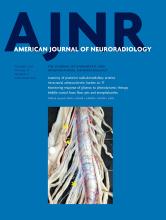Research ArticlePediatrics
Open Access
White Matter Injury and Structural Anomalies in Infants with Prenatal Opioid Exposure
S.L. Merhar, N.A. Parikh, A. Braimah, B.B. Poindexter, J. Tkach and B. Kline-Fath
American Journal of Neuroradiology December 2019, 40 (12) 2161-2165; DOI: https://doi.org/10.3174/ajnr.A6282
S.L. Merhar
aFrom the Perinatal Institute, Division of Neonatology (S.L.M., N.A.P., B.B.P.)
dDepartment of Pediatrics (S.L.M., N.A.P., B.B.P.), University of Cincinnati College of Medicine, Cincinnati, Ohio.
N.A. Parikh
aFrom the Perinatal Institute, Division of Neonatology (S.L.M., N.A.P., B.B.P.)
dDepartment of Pediatrics (S.L.M., N.A.P., B.B.P.), University of Cincinnati College of Medicine, Cincinnati, Ohio.
A. Braimah
bPediatric Neuroimaging Research Consortium (A.B.)
B.B. Poindexter
aFrom the Perinatal Institute, Division of Neonatology (S.L.M., N.A.P., B.B.P.)
dDepartment of Pediatrics (S.L.M., N.A.P., B.B.P.), University of Cincinnati College of Medicine, Cincinnati, Ohio.
J. Tkach
cDepartment of Radiology (J.T., B.K.-F.), Cincinnati Children’s Hospital Medical Center, Cincinnati, Ohio
B. Kline-Fath
cDepartment of Radiology (J.T., B.K.-F.), Cincinnati Children’s Hospital Medical Center, Cincinnati, Ohio

References
- 1.↵
- 2.↵
- 3.↵
- Towers CV,
- Hyatt BW,
- Visconti KC, et al
- 4.↵
- 5.↵
- 6.↵
- 7.↵
- 8.↵
- 9.↵
- 10.↵
- 11.↵
- Roza SJ,
- Verburg BO,
- Jaddoe VW, et al
- 12.↵
- 13.↵
- Bladowska J,
- Zimny A,
- Knysz B, et al
- 14.↵
- Kidokoro H,
- Neil JJ,
- Inder TE.
- 15.↵
- 16.↵
- 17.↵
- 18.↵
- Marelli A,
- Miller SP,
- Marino BS, et al
- 19.↵
- 20.↵
- Cornette LG,
- Tanner SF,
- Ramenghi LA, et al
- 21.↵
- 22.↵
- 23.↵
- de Bruïne FT,
- van den Berg-Huysmans AA,
- Leijser LM, et al
- 24.↵
- 25.↵
- 26.↵
- 27.↵
- 28.↵
- Hahn JS,
- Barnes PD,
- Clegg NJ, et al
- 29.↵
- 30.↵
- 31.↵
- 32.↵
- Walhovd KB,
- Moe V,
- Slinning K, et al
- 33.↵
- 34.↵
- Walhovd KB,
- Westlye LT,
- Moe V, et al
- 35.↵
- 36.↵
- 37.↵
- 38.↵
- 39.↵
- 40.↵
- Toro R,
- Leonard G,
- Lerner JV, et al
In this issue
American Journal of Neuroradiology
Vol. 40, Issue 12
1 Dec 2019
Advertisement
S.L. Merhar, N.A. Parikh, A. Braimah, B.B. Poindexter, J. Tkach, B. Kline-Fath
White Matter Injury and Structural Anomalies in Infants with Prenatal Opioid Exposure
American Journal of Neuroradiology Dec 2019, 40 (12) 2161-2165; DOI: 10.3174/ajnr.A6282
0 Responses
Jump to section
Related Articles
- No related articles found.
Cited By...
- A Prospective Multi-Institutional Study Comparing the Brain Development in the Third Trimester between Opioid-Exposed and Nonexposed Fetuses Using Advanced Fetal MR Imaging Techniques
- DTI of Opioid-Exposed Fetuses Using ComBat Harmonization: A Bi-Institutional Study
- Cerebral perfusion and neurological examination characterise neonatal opioid withdrawal syndrome: a prospective cohort study
- In utero exposure to morphine leads to sex-specific behavioral alterations that persist into adulthood in cross-fostered mice
This article has not yet been cited by articles in journals that are participating in Crossref Cited-by Linking.
More in this TOC Section
Similar Articles
Advertisement











